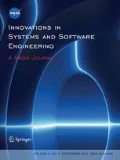Abstract
The communication and tasking infrastructure of a real-time application makes up a significant portion of any modern embedded control system. Traditionally, the tasking and communication constructs are provided by a full-fledged real-time operating system. We present an approach to automatically generate a robust framework for an application from its architectural description. This framework sits atop a Ravenscar-compliant runtime as opposed to a standard real-time operating system. We also present an extension of our approach to support code generation for high-integrity distributed applications.
Similar content being viewed by others
References
Ada Working Group (2005) Ada Reference Manual. ISO/IEC, available at http://www.adaic.com/standards/05rm/RM-Final.pdf
Aonix (2006) Real-Time RAVEN, http://www.aonix.com/pdf/RAVEN-aon.pdf
Barros MC, Madeira ER, Sotoma I (2003) An experience on CORBA component deployment. In: Proceedings of the 6th international symposium on autonomous decentralized systems (ISADS’03)
Bordin M, Vardanega T (2005) Automated model-based generation of ravenscar-compliant source code. In: ECRTS ’05: Proceedings of the 17th Euromicro conference on real-time systems (ECRTS’05), IEEE Computer Society, Washington, DC, USA, pp 59–67, http://dx.doi.org/10.1109/ECRTS.2005.9
Budinsky F, Steinberg D, Merks E, Ellersick R and Grose T (2004). Eclipse modeling framework. Addison-Wesley, Reading
Burns A and Wellings AJ (1994). HRT-HOOD: a structured design method for hard real-time systems. Real-Time Syst 6(1): 73–114 http://dx.doi.org/10.1007/BF01245300
Burns A and Wellings A (2001). Real-time systems and programming languages, 3rd edn. Addison-Wesley, Reading
Burns A, Dobbing B and Vardanega T (2004). Guide for the use of the Ada Ravenscar profile in high integrity systems. Ada Lett XXIV(2): 1–74 http://doi.acm.org/10.1145/997119.997120
Carmichael AR (1992) Defining software architectures using the hierarchical object-oriented design method (HOOD). In: TRI-Ada ’92: Proceedings of the conference on TRI-Ada ’92, ACM, New York, USA, pp 211–219, http://doi.acm.org/10.1145/143557.143721
Ellidiss Software (2007) Stood, http://www.ellidiss.com/stood.shtml
ENST (2006) Ocarina: An AADL model processing suite, http://ocarina.enst.fr, URL http://ocarina.enst.fr
Espinoza H, Dubois H, Gérard S, Medina J, Petriu DC, Woodside M (2006) Annotating UML models with non-functional properties for quantitative analysis. Satellite Events at the MoDELS 2005 Conference 3844/2006, pp 79–90
Halbwachs N (2005) A synchronous language at work: the story of lustre. In: MEMOCODE ’05: Proceedings of the proceedings. Second ACM and IEEE international conference on formal methods and models for Co-Design, 2005. MEMOCODE ’05., IEEE Computer Society, Washington, DC, USA, pp 3–11, http://dx.doi.org/10.1109/MEMCOD.2005.1487884
Hugues J, Zalila B, Pautet L (2006) Middleware and tool suite for high integrity systems
Kwon J, Wellings A and King S (2005). Ravenscar-Java: a high-integrity profile for real-time Java. Concurr Comput Pract Exp 17(5–6): 681–713
Mazzini S, D’Alessandro M, Natale MD, Lipari G, Vardanega T (2003) Issues in mapping HRT-HOOD to UML. ecrts 00:221, http://doi.ieeecomputersociety.org/10.1109/EMRTS.2003.1212747
Object Management Group (2007) Unified modeling language: superstructure. OMG, 2nd edn
de la Puente JA, Ruiz JF, Zamorano J (2000) An open Ravenscar real-time kernel for GNAT. In: Ada-Europe 2000: Proceedings of the 5th Ada-Europe international conference on reliable software technologies, Springer, London, pp 5–15
RTCA, EUROCAE (1992) DO-178B, software considerations in airborne systems and equipment certification. RTCS and EUROCAE
SAE (2004) Architecture analysis & design language (AS5506). Available at http://www.sae.org
SAE (2005) Language compliance and application program interface. SAE, the AADL Specification Document Annex D
SEI (2006) Open Source AADL Tool Environment, http://la.sei.cmu.edu/aadl/currentsite/tool/osate.html
Sha L, Rajkumar R and Lehoczky J (1990). Priority inheritance protocols: an approach to real-time synchronization. IEEE Trans Comput 39(9): 1175–1185 http://doi.ieeecomputersociety.org/10.1109/12.57058
Sha L, Klein MH and Goodenough JB (1993). Rate monotonic analysis for real-time systems. Computer 26(3): 73–74 http://dx.doi.org/10.1109/2.204696
Vestal S (1998) Software programmer’s manual for the Honeywell Aerospace Compiled Kernel (MetaH Language Reference Manual). Honeywell Technology Center, Minneapolis
Zalila B, Hamid I, Hugues J, Pautet L (2007) Generating distributed high integrity applications from their architectural description. In: 12th international conference on reliable software technologies Ada-Europe 2007, pp 155–167
Author information
Authors and Affiliations
Corresponding author
Rights and permissions
About this article
Cite this article
Hamid, I., Zalila, B., Najm, E. et al. Automatic framework generation for hard real-time applications. Innovations Syst Softw Eng 4, 107–122 (2008). https://doi.org/10.1007/s11334-008-0044-5
Received:
Accepted:
Published:
Issue Date:
DOI: https://doi.org/10.1007/s11334-008-0044-5




